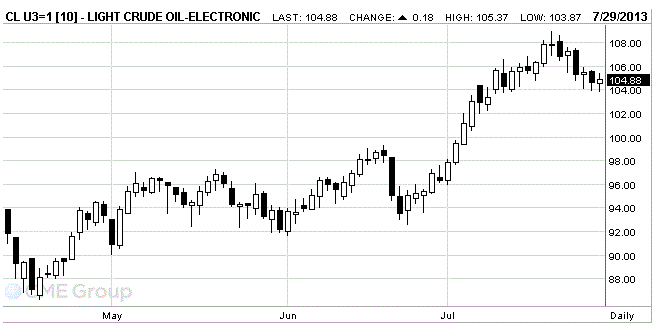Notícias do Mercado
-
16:41
Oil: an overview of the market situation
Oil prices rose slightly, to stabilize above $ 107 per barrel as a weaker dollar and concerns about supply disruptions were balanced concerns about global economic growth and the prospects for oil demand.
The data showed that the export of oil from a number of suppliers has decreased in recent weeks, stopping or reducing supplies from Libya, Iraq, North Sea and other places. Currently, the volume of deliveries fell by more than 500,000 barrels per day.
Analysts also point out that other providers, such as Sudan, may also fix the decline in exports in the coming weeks.
Production losses helped to support the market, causing concern about the prospects for fuel demand in a number of countries, including China, which is experiencing a slowdown in growth.
In addition, today it was announced that the proceeds of the Petroleum Exporting Countries on oil exports in 2012 reached a new record level. At the same time, some of the cartel profit declines on rising budget costs. Thus, if some oil-producing countries are benefiting from rising oil prices, the other members of the cartel do not get it, and this difference becomes more pronounced.
The disagreements within OPEC increase, and it is expected that later this year in the cartel will discuss the possibility of reducing the production of the official limit. If this decision is taken, the limit will be reduced for the first time in five years.
The annual statistical report of the OPEC states that the cartel's exports, including oil, gas condensate and oil products, in terms of value in 2012 increased by 9.2% to 1.261 trillion dollars, compared with the record high in 2011 at the level of 1.155 trillion dollars. Revenue Saudi Arabia grew by 6%, while revenues from Iran's oil exports fell by 12%.
The cost of the September futures on U.S. light crude oil WTI (Light Sweet Crude Oil) rose to 104.88 dollars a barrel on the New York Mercantile Exchange.
September futures price for North Sea Brent crude oil mixture rose to $ 107.35 a barrel on the London exchange ICE Futures Europe.

-
16:21
Gold: an overview of the market situation
Gold prices fell slightly, which was due to profit-taking by investors after three weeks of growth. Note also that on account of market participants addressed a meeting of the Federal Reserve System, which will take place at the end of the week, and is expected to confirm the position of the conservation interest rates close to zero.
Gold prices fell 0.2 percent, after briefly turning positive earlier. Recall that last week, gold was back above the $ 1,300 that was the first time in a month. For the past three weeks worth of precious metals increased by 9%.
Experts note that many traders prefer to stay on the sidelines ahead of the Fed meeting. In general, the participants will continue to take profits rather than trying to open a "long position" until it subsides uncertainty around the timing of the program QE.
It should also be added that influenced the trading session could have the European Central Bank and the Bank of England, which is scheduled for this week and is expected to confirm previous recommendations.
We add that this year, the price of the precious metal lost a fifth of its value against the background of signs of recovery in the U.S. economy, which caused rumors about the end of the program to purchase assets. But Ben Bernanke's comments, which were announced this month, assured investors that the central bank will reduce monetary stimulus slow pace, and had a push gold prices. Investors, however, want to hear more specific comments on the exact timing of any changes in the program, and with great attention evaluate each piece of economic data to calculate when the Fed will act.
The cost of the August gold futures on COMEX today dropped to $ 1329.60 per ounce.

-